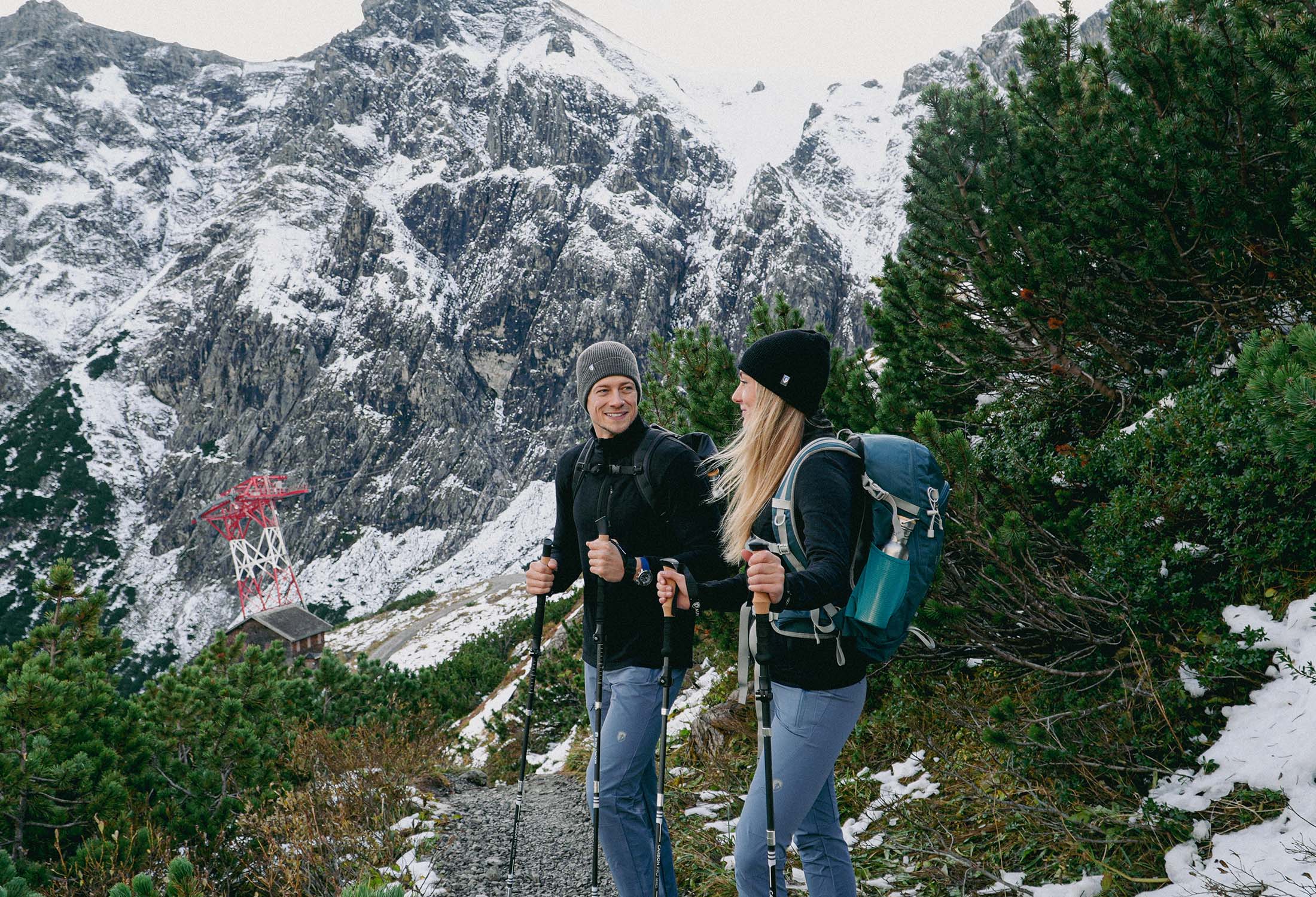A hike should primarily do one thing: refresh the body, mind, and soul. Amidst untouched nature, we find peace and can tune out the hectic world around us. However, for many people, the rude awakening comes shortly after the tour in the form of knee pain after hiking.
What causes are behind it, and how can you prevent them? You will find all this and more in the following blog post.
With our tips, the complaints will soon be a thing of the past!
How does knee pain after hiking occur?
As is often the case in life, there is not just one but several causes for knee pain after hiking. Especially the descent often leads to problems. Here, the knees are extremely challenged, as a large load rests on the joints with each step.
This exceeds a multiple of your body weight. Therefore, it is not surprising if many hikers feel knee pain during the descent. Especially when there is already a degenerative joint disease such as osteoarthritis or spondylosis, knee pain is not uncommon when hiking downhill.
A swollen knee after hiking, on the other hand, often indicates a problem with the tendons. Unlike muscles, these cannot be trained. Especially with age, the body's own collagen production decreases, so the tendons no longer have the tensile strength of a teenager.

If the knee is overstrained, severe inflammation threatens. But it's not just older people who are affected. Young hikers can also suffer from it. Tendonitis is usually recognizable by the fact that knee pain manifests itself on the outside after hiking. But the area below the kneecap can also be affected.
In addition to the mentioned conditions, a mere overstrain can also be responsible for the painful knee after hiking. Especially those who set off on long marches or even a multi-day hiking tour untrained are at risk here.
Preventing knee pain after hiking: 10 tips
Not only hikers with pre-existing conditions benefit from good health management. Knee pain after a mountain tour does not always spare even fit hikers. If you already suffer from knee problems or are unexpectedly affected while on the go, the following 10 tips can help you successfully prevent knee pain after hiking:
1. Take sufficient breaks
To prevent joint pain after a hike, regular breaks are important. This way, you can effectively counteract possible overstrain. Because often, you don't even feel the actual exertion while on the go. Therefore, plan enough breaks in advance and don't wait until the knee hurts!
2. Use hiking poles
Hiking poles not only provide you with optimal support on the go, but also offer an extra dose of joint protection. By doing so, they
- relieve muscles,
- tendons
- and joints, helping to avoid knee pain not just when hiking downhill.
They are also a real help uphill and on flat stages. If you want to learn more about joint-friendly use, check out our extensive guide. There you will find out, among other things, how you can use hiking poles correctly with these 3 techniques. More information can be found in our article: Everything about hiking poles – Guide for beginners.
3. Strengthen muscles and warm up before hiking
A well-developed musculature contributes to optimal joint protection. Therefore, you should not set off on long hikes untrained. Build your stamina slowly at first and steadily increase your workload. Stretching exercises can also support you in successfully avoiding knee pain.
4. Wear appropriate hiking shoes
The be-all and end-all for any hike are appropriate hiking shoes with good cushioning. They not only help you avoid blisters on the foot, but also ensure an optimal gait. Not only will your back be pleased, but your knees can also breathe a sigh of relief with the right hiking shoes.
You can tell if you've found the right model by the wearing comfort. If you don't feel comfortable in the shoes right away, they're not suitable for you. By the way, Merino hiking socks provide additional wearing comfort. The hiking socks are
- breathable,
- quick-drying
- and wonderfully soft.
5. Use insoles
If you already suffer from knee or back problems, insoles can help you provide good services. However, you should never use them for self-diagnosis.
To ensure that insoles optimally support you and alleviate knee problems on all your paths, they should be custom-made for you. Your family doctor or orthopedist will issue you a prescription for this. The production of insoles should be left to professionals.

6. Properly lace hiking boots
The best hiking boots and insoles are of no use if your shoes are laced incorrectly. You might wonder what could be so difficult about it. After all, the laces just need to be threaded through the eyelets and crisscrossed. But unfortunately, that's not all.
You should ensure that the tongue is actually centered. Additionally, the hiking boots should neither be laced too tightly nor too loosely. They must provide optimal support for your feet.
However, your feet tend to swell on longer hikes. Therefore, it might be useful to adjust the lacing again while on the go.
7. Take the cable car downhill
When hiking downhill, knee pain is unfortunately not uncommon. If you are already predisposed to this, a cable car ride can be a suitable health prophylaxis for you. Many hiking regions now offer cable cars.
If you get the chance along the way, take it. Your knees will thank you!
8. Stabilize knees with knee braces while hiking
Knee braces are also a promising way to avoid knee pain while hiking. Thanks to the compression, blood circulation is promoted and the risk of overexertion is minimized. However, you should only use high-quality models that are designed for medical use.
Cheap knee braces are often made of inferior materials and do not achieve the desired success. In addition to the right model, you should also ensure the correct size. The brace should be neither too loose nor too tight.
9. Pack your backpack as lightly as possible
The right packing technique and the fit of your backpack help to avoid joint pain after hiking. Make sure to only take the luggage that you actually need.
You can find valuable tips on how to properly adjust your backpack and hike without discomfort on our blog. If you are planning a longer tour , can our packing list for a multi-day hike help you.
10. Choose a suitable route
Knee pain after a mountain tour is not uncommon. To avoid this, you should definitely adapt the route to your health condition. A good hike doesn't necessarily require enormous inclines. You can enjoy the tour to your heart's content even on less steep gradients.
By the way, we have compiled the most beautiful hiking trails in Garmisch-Partenkirchen here for you.
Treating knee pain after hiking
Sometimes knee pain after hiking cannot be prevented despite good preparation and appropriate measures. If the pain is very severe, you should use painkillers to break the pain memory.
Furthermore, rest is advised. Keep your leg as still as possible at home and pause all sports activities. A swollen knee after hiking requires additional cooling in addition to immobilization.
However, wrap a cold pack with a dish towel to avoid frostbite. If there is no improvement, have your knee examined by a specialist as a precaution.

Conclusion
Joint pain after a hike unfortunately affects more and more people. But with appropriate measures and good equipment, they can be excellently prevented. Hiking poles, in particular, have proven to be excellent and allow outdoor enthusiasts with pre-existing conditions unexpected freedoms.
Even if you prefer to go high, be sure to adjust your tours accordingly. What good is the most fantastic route if you suffer from knee pain after a mountain tour? Under certain circumstances, you may have to rest for what feels like an eternity. It's not for nothing that the motto is: “Small, but fine.” Light and smaller routes also have their charm.
FAQ
Why does knee pain occur after hiking?
Knee pain after hiking can have various causes. Often the descent leads to problems because the knees are subjected to a large load that can exceed many times the body weight.
Pre-existing conditions such as degenerative joint diseases (e.g., osteoarthritis or spondylosis) can exacerbate the pain. Overloading due to untrained muscles or problems with the tendons can also lead to knee pain.
What can I do if I have knee pain after hiking despite taking precautions?
If you experience knee pain despite taking precautions, you can take the following steps:
- Use painkillers for severe pain.
- Rest your knee.
- Ice your swollen knee after the hike.
- If there is no improvement, have your knee examined by a specialist to rule out any more serious causes.
Don't miss any news and read our latest articles.


